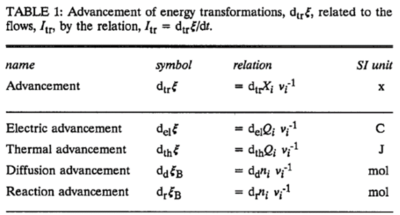Advancement: Difference between revisions
No edit summary |
No edit summary |
||
| Line 23: | Line 23: | ||
{{Keywords | {{Keywords Force and membrane potential}} | ||
== References == | == References == | ||
Revision as of 10:57, 3 January 2019
Description
In an isomorphic analysis, any form of flow is the advancement of a process per unit of time, expressed in a specific motive unit [MU∙s-1], e.g., ampere for electric flow or current, Iel = delξ/dt [A≡C∙s-1], watt for thermal or heat flow, Ith = dthξ/dt [W≡J∙s-1], and for chemical flow of reaction, Ir = drξ/dt, the unit is [mol∙s-1] (extent of reaction per time). The corresponding motive forces are the partial exergy (Gibbs energy) changes per advancement [J∙MU-1], expressed in volt for electric force, ΔelF = ∂G/∂elξ [V≡J∙C-1], dimensionless for thermal force, ΔthF = ∂G/∂thξ [J∙J-1], and for chemical force, ΔrF = ∂G/∂rξ, the unit is [J∙mol-1], which deserves a specific acronym [Jol] comparable to volt [V]. For chemical processes of reaction (spontaneous from high-potential substrates to low-potential products) and compartmental diffusion (spontaneous from a high-potential compartment to a low-potential compartment), the advancement is the amount of motive substance that has undergone a compartmental transformation [mol]. The concept was originally introduced by De Donder [1]. Central to the concept of advancement is the stoichiometric number, νi, associated with each motive component i (transformant [2]).
In a chemical reaction, r, the motive entity is the stoichiometric amount of reactant, drni, with stoichiometric number νi. The advancement of the chemical reaction, drξ [mol], is defined as,
drξ = drni·νi-1
The flow of the chemical reaction, Ir [mol·s-1], is advancement per time,
Ir = drξ·dt-1
This concept of advancement is extended to compartmental diffusion and the advancement of charged particles [3], and to any discontinuous transformation in compartmental systems [2],
Abbreviation: dtrξ [MU]
Reference: Gnaiger (1993) Pure Appl Chem
Communicated by Gnaiger E (last update 2018-11-02)
Advancement per volume
- The advancement of a transformation in a closed homogenous system (chemical reaction) or discontinuous system (diffusion) causes a change of concentration of substances i.
- The advancement causes a change of concentration due to a transformation, Δtrc, in contrast to a difference of concentrations calculated between difference states, Δtrc.
- » Advancement per volume, dtrY = dtrξ∙V-1
Template:Keywords Force and membrane potential
References
- De Donder T, Van Rysselberghe P (1936) Thermodynamic theory of affinity: a book of principles. Oxford, England: Oxford University Press:144 pp.
- Gnaiger E (1993) Nonequilibrium thermodynamics of energy transformations. Pure Appl Chem 65:1983-2002. - »Bioblast link«
- Prigogine I (1967) Introduction to thermodynamics of irreversible processes. Interscience New York, 3rd ed:147 pp. - »Bioblast link«
MitoPedia concepts: MiP concept, Ergodynamics

